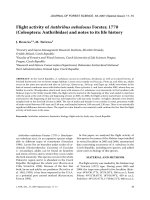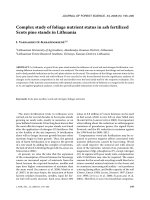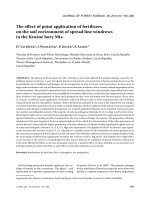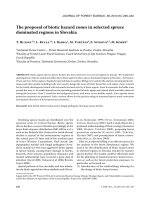Báo cáo lâm nghiệp: "Field studies of leaf gas exchanges (Elaeis guineensis Jacq.)" pdf
Bạn đang xem bản rút gọn của tài liệu. Xem và tải ngay bản đầy đủ của tài liệu tại đây (167.48 KB, 4 trang )
Field
studies
of
leaf
gas
exchanges
in
oil
palm
tree
(Elaeis
guineensis
Jacq.)
E. Dufrene
B. Saugier
Laboratoire
d’Ecologie
V6g6tale,
Universit6
Paris-Sud,
91405
Orsay
Cedex,
France
Introduction
This
study
is
part
of
a
larger
research
pro-
gram
on
climatic
and
biological
factors
affecting
oil
palm
yield.
Our
purpose
was
to
characterize,
under
conditions
of
good
water
supply,
variations
in
leaf
photosyn-
thesis
with
internal
and
external
factors.
Several
authors
have
been
working
on
the
C0
2
assimilation
rate
(A)
in
oil
palm.
Most
of
them
have used
young
plants
under
laboratory
conditions
to
study
effects
of
photosynthetically
active
radia-
tion
(Corley
et
al.,
1973;
Hirsch,
1975),
foliar
temperature
(Hong
and
Corley,
1976)
or
leaf
water
potential
and
stomatal
conductance
(Adjahossou,
1983).
Only
2
experiments
were
conducted
in
the
field:
Bolle-Jones
(1968)
determined
the
amount
of
soluble
sugars
in
9
yr
old
leaf-
lets
and
Corley
(1983)
observed
the
effects
of
leaf
senescence
on
photosyn-
thesis
using
the
14CO
2
method.
L
R.H.O.:
Institut
de
Recherche
sur
les
Huiles
et
les
01,
In
this
study,
we
evaluated
variations
in
leaf
photosynthesis
in
8
trees
of
the
same
progeny,
and
the
effect of
vapor
pressure
deficit
(VPD
=
es
(T
a
) -
ea)
and
leaf
tem-
perature
( T
t)
on
stomatal
conductance
and
leaf
gas
exchanges.
Materials
and
Methods
The
study
site
was
located
at
the
LR.H.O.
V
C.LR.A.D.
2
experimental
station
of
La
Me
near
Abidjan,
Ivory
Coast
(5°26’N
Lat.,
3°50’W
Long.).
The
studied
trees
belong
to
one
single
line
(L2T
*
D10D)
used
as
a
reference
in
many
trials
of
the
production
area
and
char-
acterized
by
a
moderate
vegetative
develop-
ment
associated
with
good
bunch
production.
The
net
C0
2
assimilation
rate
(A)
was
mea-
sured
using
a
leaf
chamber
(PLC,
A.D.C.3)
and
a
portable
C0
2
analyzer
(LCA2,
A.D.C.)
connected
in
an
open
system.
Leaf
tempera-
ture,
transpiration
rate,
boundary
layer
and
sto-
matal
conductances
were
calculated
using
the
energy
balance
equation
(Parkinson,
1985)
combined
with
standard
equations
(von
Caem-
merer and
Farquhar,
1981
).
6agineux.
1
I.R.H.O.:
Institut
de
Recherche
sur
les
Huiles
et
les
0[6agineux.
2
C.I.R.A.D.:
Centre
de
Cooperation
International
en
Recherche
Agronomique
pour
le
D6veloppement.
3
A.D.C.:
Analytical
Development
Company.
Results
Fig.
1
shows
measurements
made
on
the
8th
or
9th
leaf
of
8
different
palm
trees
(last
leaf
fully
opened
is
numbered
1
).
Light
was
the
only
limiting
factor.
Relative
error
of
measurements
in
low
light
was
too
high
to
allow
a
comparison
of
apparent
quantum
yield
between
trees.
Maximal
leaf
assimilation
rates
(PAR
higher
than
1100
pmol
’
m-
2’
s-
1)
were
not
significantly
different
between
trees
(F=
1,
dF= 52).
The
maximal
C0
2
assimilation
rate
decreased
with
leaf
age
in
10
yr
old
oil
palm
(Fig.
2).
This
decrease
became
more
pronounced
at
leaf
number
higher
than
25
(=
2
yr
old),
when
maximal
stomatal
conductance
was
also
decreasing.
The
net
C0
2
assimilation
rate
was
slightly
sensitive
to
VPD
increase
up
to
1.7
kPa,
and
then
it
dropped
steadily
(Fig.
3a).
The
transpiration
rate
decreased
linearly
with
VPD
because
of
rapid
stoma-
tal
closing
(Fig.
3a,
b).
There
was
no
change
in
the
C0
2
assimilation
rate
as
a
result
of
changes
in
leaf
temperature
(Fig.
3c).
The
transpiration
rate
and
stomatal
conductance
increased
with
leaf
tempera-
ture
(Fig. 3c, cl).
Discussion
and
Conclusion
The
maximal
photosynthesis
observed
in
5
yr
old
oil
palm
(A
=
23.70
!rmol!m-2!s-!)
was
not
very
different
from
Corley’s
(1983)
results
(A
=
20
pM
ol-M-
2
-S-1,
3
yr
old
trees,
leaf
number
10).
This
high
C0
2
assimilation
rate
is
quite
similar
to
those
of
fast
growing
temperate
trees,
such
as
Populus
sp.
((:eulemans
et aL,
1987)
and
slightly
higher
than
those
of
wet
tropical
forest
and
crop
trees
(Mooney
et aL,
1984.
Leaf
temperature
between
30 and
38°C
had
no
effect
on
photosynthesis
which
shows
an
adaptation
to
high
temperatures
in
this
tropical
C3
species.
Observed
stomatal
opening
with
in-
creases
in
temperature
is
a
classical
re-
sponse
that
is
often
concealed
by
a
simul-
taneous
variation
in
VPD
(Jarvis
and
Morison,
1981).
When
VPD
increases
above
about
1
kPa,
it
causes
a
rapid
sto-
matal
closure
that
induces
a
decrease
in
the
transpiration
rate,
despite
a
high
eva-
porative
demand.
Stomatal
sensitivity
to
VPD
has
been
reported
in
numerous
spe-
cies
(Farquhar
et
aL,
1980;
El
Sharkawy
et al.,
1984).
It
is
especially
pronounced
in
oil
palm
and
confers
good
survival
capability
to
overcome
drought
to
this
spe-
cies
but
strongly
reduces
bunch
produc-
tion.
References
Adjahossou
D.F.
(1983)
Contribution
a
I’dtude
de
la
resistance
a
la
s6cheresse
chez
le
pal-
mier
a
huile
(Elaeis
guineensis
Jacq.)
Ph.D.
Thesis,
Université
Paris
VII,
France
Bolle-Jones
E.W.
(1968)
Variations
of
chloro-
phyll
and
soluble
sugar
in
oil
palm
leaves
in
relation
to
position,
time
of
day
and
yield.
Olea-
gineux 23,
505-511
l
Ceulemans
R.,
Impens
1.
&
Steenackers
V.
(1987)
Variations
in
photosynthetic,
anatomical
and
enzymatic
leaf
traits
and
correlations
with
growth
in
recently
selected
Populus
hybrids.
Can.
J.
For.
Res.
17, 273-283
Corley
R.H.V.
(1983)
Photosynthesis
and
age
of
oil
palm
leaves.
Photosynthetica
17,
97-100
Corley
R.H.V.,
Hardon
J.J.
&
Ooi
S.C.
(1973)
Some
evidence
for
genetically
controlled
varia-
tion
in
photosynthetic
rate
of
oil
palm
seedlings.
Euphytica
22,
48-55
EI-Sharkawy
M.A.,
Cock
J.H.
&
Held
A.A.K.
(1984)
Water
use
efficiency
of
cassava.
11.
Dif-
fering
sensitivity
of
stomata
to
air
humidity
in
cassava
and
other
warm-climate
species.
Crop
Sci.
24,
505-507
Farquhar
G.D.,
Schulze
E.D.
&
Kuppers
M.
(1980)
Responses
to
humidity
by
stomata
Nicotiana
glauca
L.
and
Corylus
avellana
L.
are
consistent
with
the
optimization
of
carbon
diox-
ide
uptake
with
respect
to
water
loss.
A
usf.
J.
Plant
Physiol.
7,
3i 5-327
Hirsch
P.J.
(1975)
Premiers
travaux
sur
I’assimi-
lation
photosynth6tique
du
palmier
huile
(Elaeis
guineensis
Jacq.).
Thesis,
ORSTOM-
RHO,
La
M6,
Ivory
Coast
Hong
T.K.
&
Corley
R.H.V.
(1976)
Leaf
temperature
and
photosynthesis
of
a
tropical
C3
plant
Elaesis
guineensis.
Mardi
Res.
Bull.
4, 16-
20
Jarvis
P.G.
&
Morison
J.I.L.
(1981)
Stomatal
control
of
transpiration
and
photosynthesis.
In:
Stomatal
Physiology.
(Jarvis
P.G.
&
Mansfield
T.A.,
eds.),
Cambridge
Univ.
Press,
Cambridge,
pp. 247-279
Mooney
H.A.,
Field
C.
&
Vasquez-Yanes
C.
(1984)
Photosynthetic
characteristics
of
wet
tropical
forest
plants.
In:
Physiological
Ecology
of
Plants
of
the
Wet
Tropics.
(Medina
E.,
et
al.,
eds.),
Dr.
W.
Junk
Pubi.,
The
Hague,
pp.
113-
128
Parkinson
K.J.
(1985)
A
simple
method
for
determining
boundary
layer
resistance
in
leaf
cuvettes.
Plant
Cell
Environ.
8,
223-226
von
Caemmerer
S.
&
Farquhar
G.D.
(1981)
Some
relationships
between
the
biochemistry
of
photosynthesis
and
the
gas
exchange
of
leaves.
Planta
153,
376-387









